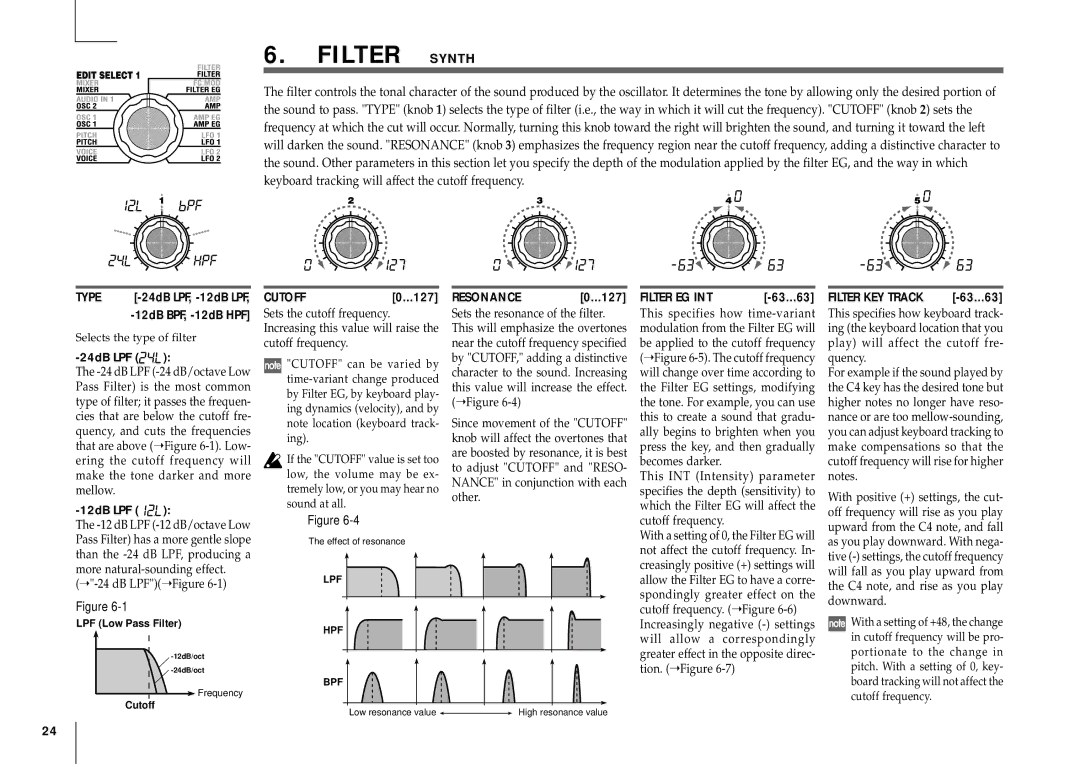
6.FILTER — SYNTH
The filter controls the tonal character of the sound produced by the oscillator. It determines the tone by allowing only the desired portion of the sound to pass. "TYPE" (knob 1) selects the type of filter (i.e., the way in which it will cut the frequency). "CUTOFF" (knob 2) sets the frequency at which the cut will occur. Normally, turning this knob toward the right will brighten the sound, and turning it toward the left will darken the sound. "RESONANCE" (knob 3) emphasizes the frequency region near the cutoff frequency, adding a distinctive character to the sound. Other parameters in this section let you specify the depth of the modulation applied by the filter EG, and the way in which keyboard tracking will affect the cutoff frequency.
TYPE | |
|
Selects the type of filter
![]()
![]()
![]() ):
):
The
-12dB LPF (

 ):
):
The
(➝ "-24 dB LPF")(➝ Figure 6-1)
Figure
CUTOFF[0...127]
Sets the cutoff frequency. Increasing this value will raise the cutoff frequency.
![]() "CUTOFF" can be varied by
"CUTOFF" can be varied by
If the "CUTOFF" value is set too low, the volume may be ex- tremely low, or you may hear no sound at all.
Figure
The effect of resonance
LPF
RESONANCE [0...127]
Sets the resonance of the filter. This will emphasize the overtones near the cutoff frequency specified by "CUTOFF," adding a distinctive character to the sound. Increasing this value will increase the effect. (➝ Figure
Since movement of the "CUTOFF" knob will affect the overtones that are boosted by resonance, it is best to adjust "CUTOFF" and "RESO- NANCE" in conjunction with each other.
FILTER EG INT |
|
This specifies how
This INT (Intensity) parameter specifies the depth (sensitivity) to which the Filter EG will affect the cutoff frequency.
With a setting of 0, the Filter EG will not affect the cutoff frequency. In- creasingly positive (+) settings will allow the Filter EG to have a corre- spondingly greater effect on the cutoff frequency. (➝ Figure
FILTER KEY TRACK |
|
This specifies how keyboard track- ing (the keyboard location that you play) will affect the cutoff fre- quency.
For example if the sound played by the C4 key has the desired tone but higher notes no longer have reso- nance or are too
With positive (+) settings, the cut- off frequency will rise as you play upward from the C4 note, and fall as you play downward. With nega- tive
LPF (Low Pass Filter)
HPF
BPF
![]() Frequency
Frequency
Cutoff
Low resonance value ![]()
![]() High resonance value
High resonance value
Increasingly negative
![]() With a setting of +48, the change in cutoff frequency will be pro- portionate to the change in pitch. With a setting of 0, key- board tracking will not affect the cutoff frequency.
With a setting of +48, the change in cutoff frequency will be pro- portionate to the change in pitch. With a setting of 0, key- board tracking will not affect the cutoff frequency.
24
